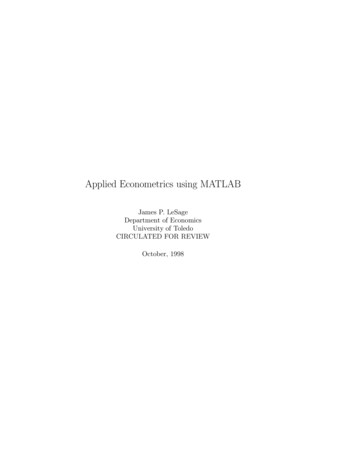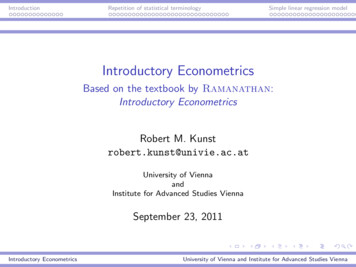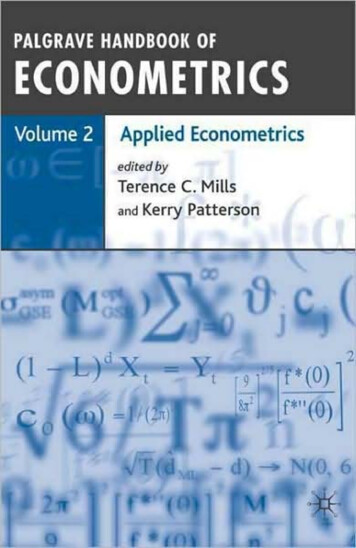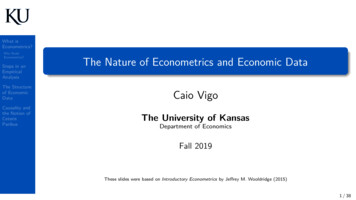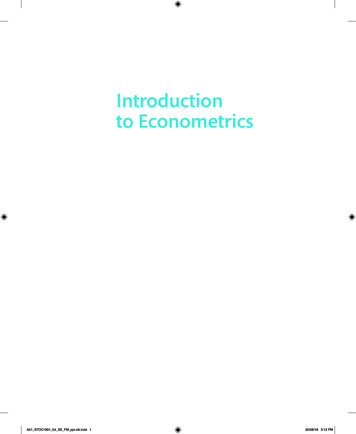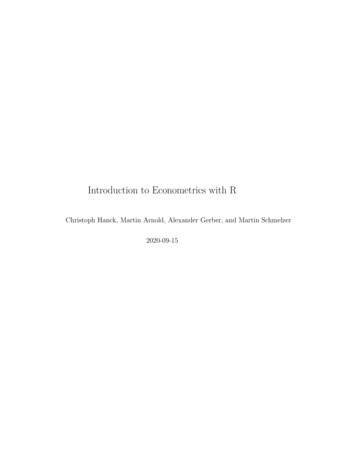
Transcription
International Journal of Research in Humanities and Social StudiesVolume 6, Issue 2, 2019, PP 32-41ISSN 2394-6288 (Print) & ISSN 2394-6296 (Online)An Econometrics Analysis of the Determinants of EconomicGrowth in the Gambia1Tsenkwo, BM. Joseph, 2Momodou Mustapha Fanneh, 3Christopher Belford, 4Ebrima K.Ceesay12,3&4Faculty of social sciences, Department of Economics, University of Jos, NigeriaSchool of Business and Public Administration, Department of Economics, University of theGambia*Corresponding Author: Momodou Mustapha Fanneh, School of Business and PublicAdministration, Department of Economics, University of the Gambia. Email : mmfanneh@utg.edu.gmABSTRACTEmpirical investigation on the estimate of the drivers of economic growth in the Gambian economy havelargely been descriptive in nature and seldom without precision, in the magnitude of sectoral contributionsto this growth pattern over time. The main objective of this paper is to obtain the quantitative estimates ofsectors accounting for the growth in the Gambia. The Autoregressive Distributed lag (ARDL) dynamictechnique augmented with qualitative analysis was adopted. Both findings from the analyses reinforced oneanother. In the trend analysis, the movement in the growth rate of the agricultural sector perfectly predictedthe growth rate the Gambian proxied by GDP, followed by the service sector, while the tourism sectortrailed behind. While in the quantitative analysis, agriculture and the servicing sectors were the leaders ofgrowth drivers in the Gambia. Both variables have significant positive impact of the target variable (GDP)in the long run. The seasonality nature of the tourism sector affected the growth of the economy only in theshort run. In conclusion, it is assured that the agriculture and service sectors have long lasting impact onthe growth rate of the Gambian economy.Keywords: Econometrics, Economic growth, AgricultureJEL CLASSIFICATION: C38, F44INTRODUCTIONThe Gambia is one of the smallest country inmainland Africa, located at the extreme west ofWest Africa with latitude -13º28¹ and longitude-15º31¹. The country is surrounded on threesides i.e. the north, east and south by the sistercountry, the Republic of Senegal and on thefourth side i.e. the west by the Atlantic Ocean.The two republics (Senegal & The Gambia)share a similar socio-cultural heritage andaffiliation. While the Gambia attained peacefulindependence from British colonial rule on the18th February 1965, the republic of Senegal wascolonized by the French and speak French as itsofficial language. But the Gambian officiallanguage is English. The ethnicity of TheGambia is composed of mainly Mandinka,Wollof, Fula, Jola, Sarahule, Serer, Manjago,and Creole (known as Aku). The population ofthe Gambia as per the 2013 population andhousing census was 1.8 million by the GambiaBureau of Statistics. According to the 2013Population census report, the country has a totalpopulation of 1.9 million inhabitants with theaverage annual growth rate of 3.2 percent and65 per cent under the age of 25 years (GBoS,2015). From the 2009 estimate The Gambia hasan average of life expectancy of 53.8 years and50.8 from the recent Gambia Public expenditureReview of the education sector, there is a youthliteracy rate of (15 years and above). Thecountry has a total area of 11,300km2(4388sq.miles), of which the water bodies have1,300sq km (MoFEA, 2017)The Gambia is amongst the most denselypopulated countries in Africa and thus exertedtremendous pressure on the country‟s limitedand scarce productive resources. Thissometimes prevented social and economicservices from being adequately provided to itscitizenry and other inhabitants. Due to the rapidgrowth in population coupled with highurbanization rate and divergent growth inincome and wealth, inequality of all sortsremains a critical issue for The Gambians. Thegovernment of The Gambia has devisedpolicies, programmes and legal frame work toaddress the aforesaid inequalities and curb rural-International Journal of Research in Humanities and Social Studies V6 I2 201932
An Econometrics Analysis of the Determinants of Economic Growth in the Gambiaurban gap in income and wealth over the years.Another important concern to the government ofrecent years is the growing phenomenon ofillegal youth migration to Europe locallyreferred to as the “Backway Syndrome”. Thissituation has far-reaching economic and socialconsequences on the development of TheGambia.According to Jallow (2015 the Gambia, like alldeveloping countries, have significant numberof people living on less than 1.25 a day. Thelast poverty survey, i.e. Integrated HouseholdSurvey 2010, estimated the poverty headcount at48.4 percent for those living on less than 1.25 aday, with over 73 percent of them staying in therural areas” (p. 20). Most of the poor in TheGambia are rural dwellers whose earnings aremainly from subsistence farming, which canbarely maintain their annual needs henceresulting to various forms of deprivation. Inalmost all rural farming communities farmersare unable to satisfy their most essential basicneeds.On the Health front, The Gambia has achievedremarkable progress and results. Infant mortalityand mortality of children under the age of 5years have reduced in the last decade and morethan 60 percent of births are currently attendedby skilled health personnel. Both healthexpenditure as a percentage of GDP and lifeexpectancy have increased modestly. Given theimportance of health in economic growth andespecially in development there is a need toconsolidate these strides as efforts are made toattain the Sustained Development Golds(SDGs). Education being a fundamental pillarfor growth and development has witnessedincreased enrolment in secondary schooleducation recent years. Gender parity in seniorsecondary education was reached in 2016.However the difference in school enrolmentbetween urban and rural areas remains achallenge due to poverty and awareness issuesinruralsettlements(UnitedNationsCommission for Africa, 2016).Agriculture is a significant real sector of TheGambian economy contributing to real GossDomestic Product (GDP) of 21% in 2015 ascompared to 20% in 2014 (MOFEA, 2017). Thesector over the years have been characterized bynumerous problems, inhibiting The Gambia‟sdrive towards food self-sufficiency andagriculture commercialization, despite variousprojects and policy interventions.33The Gambian Economy is limited to a small,undiversified market with tourism andagriculture as the main drivers of growth, thegrowth rate has experienced highly volatilityover the years, growth in recent years havefluctuated from -4.3 percent in 2011 to 5.9percent in 2012 and back to 0.9 percent in 2014(Foroyaa, 2018). The economy of the Gambia isalso dependent on service sector (tourism sector,financial sectors, telecommunications sectoretc.). The services sector accounted for only 55percent of growth, agriculture which employsabout 70 per cent of the population, accountedfor only 28 percent of GDP (MoFEA, 2011).Exogenous factors such as climate changemanifested by draught and the outbreak of Ebolavirus disease in West Africa have caused anendangering stability in the country‟s economy.Also Endogenous factor such as the recentpolitical impasse created shock on the sluggishgrowth been experienced over the period. Theeconomy of The Gambia is largely operated onfiscal deficits and heavy debt burden (estimatedat 8.7% and 100% of GDP, respectively, in2014) this situation poses a major challenges todevelopment. In particular, interest paymentsconsume about 22.5% of government revenues(including 81% devoted to domestic debt). Thenet domestic borrowing (NDB) rate is expectedto reach 12% of GDP at the end of 2014 againstthe less than 2.5% projected at the beginning ofthe year. As of end-2014, the main targetsstipulated in the International Monetary Fund(IMF) Extended Credit Facility (ECF) were offtrack. The IMF has confirmed its willingness togrant a Rapid Credit Facility (RCF) and provideemergency financial assistance to respond to thecountry‟s external shocks (Ebola and thedrought) provided that the authorities implementa series of policy measures including inparticular restructuring the energy sector(UNECA, 2016).Rigorous empirical studies using the Gambiadata to estimate the coefficient of determinantsof economic growth is grossly inadequate or outrightly lacking. What probably are available aremainly some descriptive analyses basedqualitative narratives that do not providequantitative estimates and the point to thefactors of the growth rate over the years.Therefore this study is intended to usesecondary data to identify and estimate thedeterminants of growth employing econometricsanalysis which has become strong analyticaltechnique used by economists to come up withcoefficients of economic phenomenon. Thus,International Journal of Research in Humanities and Social Studies V6 I2 2019
An Econometrics Analysis of the Determinants of Economic Growth in the Gambiafollowing from the introduction as sectionabove, to follow next is section two whichprovide survey of existing literature of thesubject matter. Section three discusses themethodology to be used for the study. Datapresentation analysis will form the crux ofsection four where raw data will be displayedanalysed and discussed, the paper will sum-upthe entire work in section five with summary,conclusions and recommendations.REVIEW OF RELETED LITERATUREAn analysis on the subject of growth isnumerous in academic literatures over a periodhas revealed that growth determinates are:Human Capital, Innovation & Research &Development, Openness to Trade or ForeignDirect Investments, Institutions, just to name afew. The focus of this paper will be an academicassessment of the aforementioned as it relates toThe Gambia.According to Tridico (2007) an improvement inthe skills of workers will increase returns toscale of knowledge, ceteris paribus, simplybecause skilled workers are more productive.Knowledge is strictly connected with school andeducation. Hence those workers with betterskills are more productive ceteris paribus. In thesame paper, Tridico cited, Lucas (1988) inwhich he directly associated the human capitalwith “learning by schooling” and “learning bydoing”, allowing human capital to becomereproducible. Physical capital integrated by thisdefinition of human capital is part of acumulative and reproducible process whichavoids decreasing return to scale; this illustratesthe significance of skills acquisition andeducation in an economy.In their study of determinates of economicsgrowth Petrakos and Arvanitidis (2007),postulate that human capital is the main sourceof growth in several endogenous growth modelsas well as one of the key extensions of theneoclassical model. They referred to „humancapital‟ as, principally a workers‟ acquisition ofskills and know-how through education andtraining, they suggested that majority of studieshave measured the quality of human capitalusing proxies related to education such as schoolenrolment rates, tests of mathematics andscientific skills, etc. On those grounds, theypointed to several studies that have foundevidence that an educated labour force is a keydeterminant of economic growth (Barro, 1991;Mankiw et al, 1992; Barro and Salai Marin,1995; Brunetti et al, 1998, Hanushek andKimko, 2000). Hence, education is relevance toeconomic growth over a period of time.However, they also expounded on other scholarswho have questioned these findings and,consequently, the importance of human capitalas substantial determinant of economic growth(Levine and Renelt, 1992; Benhabib andSpiegel, 1994; Topel, 1999; Krueger andLindahl, 2001; Pritchett, 2001). Since there areschools of thought that argue to the contraryabout the link between human capital andeconomic growth.Boldeanu and Constantinescu (2015) buttressedthat economic openness can have an importantinfluence on economic growth throughnumerous channels like technological transfers,competitiveness advantage and increase ineconomies of scale. They cited (Chang et al.2009). Edward (1992) which showed that tradeopenness has a favourable effect on real GDPand that trade liberalization will accelerateeconomic growth and countries will be capableto enter more easily foreign markets, there byfacilitatingandexpandingeconomicopportunities for growth. They also cited,Ynikkaya (2003) also analyzed the influence oftrade openness on growth for 120 countriesbetween 1970 and 1997. He used severalvariables to measure openness like for examplevolume of exports, volume of imports, the sumexports and import and the volume of trade withdeveloped countries. He also used trade policyvariables for measuring restriction or opennessof trade. The result concluded that for developedand developing states the indicators thatmeasure the volume of trade have a positiveeffect on growth; this goes to illustrate theimportance and significance of an openedeconomy to ensure a buoyant growing economicperformance.(Petrakos & Arvanitidis., 2007), stressed that,Foreign Direct Investment (FDI) has recentlyplayed a crucial role of internationalizingeconomic activity and it is a major source oftechnology transfer and economic growth. Therole of FDI in the aforementioned is stressed inseveral models of endogenous growth theory.Various empirical literature have examined theimpact of FDI on growth has provided aconsistent findings affirming a significantpositive link between FDI and growth as citedin, (e.g. Borensztein et al, 1998; Hermes andLensink, 2000; Lensink & Morrissey, 2006).This argument goes to reinforce the prominenceof an open economy in influencing growthpositively over time.International Journal of Research in Humanities and Social Studies V6 I2 201934
An Econometrics Analysis of the Determinants of Economic Growth in the GambiaKogid Mulok Beatrice and Mansur (2010),cited Li and Liu (2005) studied on whether FDIaffected economic growth based on panel datafor 84 countries from the year 1970 to 1999.Single and simultaneous systems of equationtechniques were used to test this relationship.Their research found a significant relationshipbetween FDI and economic growth which wasidentified from the mid-1980s and after.Strengthening how FDI and growth arecorrelated over time in the sample data set, thisevidence thus continues to show the linkbetween the two variables.In their growth study (Petrakos,. & Arvanitidis,2007), discussed that Innovation and R&Dactivities how they can play a major role ineconomic advancement, increasing productivityand growth. This according to them is due toincreasing use of technology that enablesintroduction on of new and superior processesand products thus improving the quality ofeconomic output with value addition. This rolehas been stressed by various endogenous growthmodels, pointing out the strong relation betweeninnovations on and/or R&D and economicgrowth has been empirically affirmed bynumerousstudies(Fagerberg,1987;Lichtenberg, 1992; Ulku, 2004). Thus the linkbetween the two is expedient to lead to growthin an economyAccording to (Tridico, 2007), various economicresearches showed that institutions and goodgovernance, in some ways, matter in economicorganization and rising productivity asmentioned by (Knack and Keefer, 1994; Olsonet al 1998; Jones and Hall 1999; Acemouglu et.al., 2001; etc). Institutions are in general definedas “the rules of the game”. A more sophisticatedefinition of institutions is “a set of social rulesthat structure social interactions” (Knight 1992,p. 2). If we consider this definition ofinstitutions,thentheexplanationofdevelopment should be consistent with that ofKuznets (1965, p. 30): “the transformation of anunderdeveloped in to a developed country is notmerely the mechanical addition of a stock ofphysical capital: it is a thoroughgoing revolutionin the patterns of life and a cardinal change inthe relative powers and position of variousgroups in the population”. Consequently, inorder to change institutions, the prevalent socialrules need to be changed, which should lead toadvancement over a period of time therebyimproving the life and livelihoods its membershence increasing output leading to growth.35As stressed by (Petrakos. & Arvanitidis, 2007),from the study of Rodrik (2000) whohighlighted 5 key institutional structures such n for macroeconomic stabilization,institution for social insurance and institution ofconflict management, which, he argued do notonly exert direct influence on economic growth,but also aff ect other determinants of growthsuch as the physical and human capital, theinvestmentdecisionsand technologicaldevelopments. Hence the importance ofinstitution to create the necessary rules,conditions and structures to facilitate interactionwith and among economic players therebysupporting growth in the processTHE GAMBIAN ECONOMY: STYLIZEDFACTSEconomic growth in The Gambia is mainlydriven by the agricultural sector (22.5% of GDPin 2016) and the tertiary sector (66% of GDP),including tourism (30.3% of GDP). Both sectorsare vulnerable to exogenous shocks as shown inrecent growth performance. Agriculture, themost pro-poor sector of the economy, accountsfor a large percentage of employment in thecountry and is one of the main drivers ofeconomic growth. It continues to be prioritizedin the allocation of Government resources.Tourism also continues to play a significant rolein the services sector and contributed strongly toeconomic growth in 2016 and 2017. It remainsthe leading foreign exchange earner in theeconomy. The tourism sector is booming. Toconsolidate these gains, it needs to improve itscompetitiveness and address the supply sideconstraints that continue to stifle growth.Average GDP growth rate was about 3.6% overthe past decade (2007-2016) but fluctuated froma high positive rate of 6.4% in 2008 to negativegrowth (minus 4.3%) in 2011. Following aseries of exogenous shocks and a tumultuouspolitical transition, GDP growth fell from 4.3%in 2015 to 2.2% in 2016. An unusually shortrainy season in 2016 reduces agriculturalproduction by at least 50%. Meanwhile,spillover effects from the regional Ebola crisisdamaged the tourism sector. A three monthborder blockade by Senegalese transporters in2016 also depressed economic activity. Thepolitical crisis in the final months of the yearcompounded these shocks, disrupting transittrade, manufacturing, and mining activity. Anuncertain political climate caused tourist arrivalsto fall 20% below expected levels by the end ofInternational Journal of Research in Humanities and Social Studies V6 I2 2019
An Econometrics Analysis of the Determinants of Economic Growth in the Gambiathe year, though arrivals remained above their2014-2015 levels.METHODOLOGYThe paper adopted applied research design andused existing data from World DevelopmentIndicator for Gambia. The AutoregressiveDistribute Lagged (ARDL) econometrictechnique use to explain the interaction betweenthe variables identified as the determinants ofeconomic growth in the Gambia. Theautoregressive distributed lagged is a dynamicanalytical technique that links the effect ofendogenous variable not only to the exogenousvariables, but also to its past lagged effect ofitself. Most economies operate in a dynamicenvironment in the world nowadays, as such it isonly a dynamic tools of analysis can yield a truepicture of what is in the system as opposed tothe traditional static one that has been in usedfor long time in the classical system.In 2017, grew by 3.5%, following a betteragriculture season and a strong rebound in tourism and trade. The agricultural sector recorded5.5% growth in 2017, compared to 0.5% thepreceding year. Crop production rose by 7.6%and livestock by 3.8% (compared to 3.2% in2016). Forestry and fishing also grew, by 3.0%(3.0% in 2016) and 5.3% (3.5% in 2016)respectively. Industry too experienced positivegrowth (6.5%), after contraction by 3.1% in2016. The mining and quarrying sub-sectorgrew by 5.7% after contracting 10.3% theprevious year. The construction sector recorded11.7% growth in 2017 compared to minus 5.9%in 2016. Service sector growth experienced asmall setback, falling from 5.1% in 2016 to4.5% growth in 2017. The hotel and restaurantsector grew by only 5% in 2017 compared to19.7% in 2016. The lower performance of theservice sector is due to the negative impact ofthe December 2016 political crisis that affectedthe tourism sector and led to low hoteloccupancy between January and March 2017.As tourism is the largest sub-sector in theservices sector, this caused an overallcontraction in the sector. Communications grewby 13.5% in 2017, compared to 9.3% in 2016.While all services sub-sectors experiencedpositive growth, most have registered a smallergrowth in 2017 than 2016.The analysis will commenced with a descriptiveanalysis using trend graphs to illustrate thejoined interaction of the variables used in themodel. This will shed light on their associationsover the period considered in the study. Thetrend graphs will also show the extent to howany, have drifted away arising from anystructural shocks either internally or externallyand to provide the basis to investigate thecauses.Model Specification and EstimationTechniqueThe theoretical underpinning of autoregressivedistributed lagged is credited to Pesarantassumed popularity as a potent technique ofanalysis of time series data to take in thepeculiar characteristics of time series data interms of trending nature. Thus ARDL addressesthe time series problems and distribute the pasteffect of individual variable effect in the model.This basic model for Autoregressive DistributedLag (ARDL) is theoretically specified asOverall, consumption expenditure increased byup to 12% in 2017 compared to 2016.Household consumption represented 90% oftotal expenditure. Government expenditureincreased by up to 22% relative to 2016. Totalinvestment rose by up to 6% compared to theprevious year. Investment in construction witnessed significant growth of 13%. Investment indurable capital goods increased by 1%. t 0 p yi 1pt 1 t 1pt 1 CFi 1Where 0 is the drift component, 0 is thewhite noise. The term with the summation signsrepresent the error correction, with t torepresent the short run effects and the secondcomponent of the equation with correspondsto the long run relationship.It can as well be written in a compact matrixform shown in equation 1 belowtp Pt 1i 1 t Yt 1 2 t 1 3CFt 1 . (1) t t t 1 t 1 tp(2)t 1Where Δ is the first difference operator, the longrun multiplier matrix λ is stated below as t yy yy yy yy International Journal of Research in Humanities and Social Studies V6 I2 2019(3)36
An Econometrics Analysis of the Determinants of Economic Growth in the GambiaThe diagonal elements of the matrix areunrestricted so the selected series can either I (0)or I (1). In contrast, if λyy 0, then y is I(0). Tobring down this to our study specification, wefollow the postulations made by Pesarant et al(2001) with unrestricted intercepts and notrends. After imposing restrictions to λyy 0,and α 0. The growth nexus can be stated in thefollowing unstricted error correction modelΔ(lnGDP) β0 β1(lnGDP)t-1 β2(lnAGRIC)t-1 β3(lnTOUR)t-1 β4(lnSERV)t-1 β6Δ(lnGDP)t-1) β6Δ(lnAGRIC)t-1) β7Δ(lnTOUR)t-1) β8Δ(lnSERV)t-1) μt (4)Where Δ is the first difference operator and μ t isthe white noise disturbance term. Equation 2 canas well be written in an ARDL of the order (p qr s).The equation indicates that economicgrowth in the Gambia can be influenced andexplained by its past values, adaptive processwhich future forecast is based. The structuralequation 1 is established by using n 4 is composed of twocomponents, the long run and the shortcomponents stated asln(GDP) β0 β1(lnAGRIC)t-1 β2(lnTOUR)t-1 β3(lnSERV)t-1 β4Δ(lnAGRIC)t-1) β6Δ(lnTOUR)t-1) β7Δ(lnSERV)t-1) μt (5)Which can be interpreted as the long run and the lag length determined by the lag order var, thesecond component is the short run equationΔ(lnGDP) β0 γ 6Δ(lnGDP)t-1) Φ Δ(lnAGRIC)t-1) δ Δ(lnTOUR)t-1) κ Δ(lnSERV)t-1) vecm μt .(6)Where γ, Φ, δ and κ are short run dynamiccoefficients that converged at equilibrium and vtis expected to have a negative coefficientinterpreted as the speed of adjustment toequilibrium.Figure1. Trend Graph Growth Determinants in the Gambia.Sources: Authors ComputationsDATA ANALYSISDescriptive AnalysisThe trend graph presented in figure 1 belowshows the individual performance of thevariables considered as the growth determinantsin the Gambian economy for the period of thestudy. It can be seen from the graph that somevariables have performed above average such asinternational tourism, services sector, while37GDP and Agriculture marginally performed.The key variable, which is the growth variablehas intermittently responded positively andnegatively with some variables for the period ofthe analysis. In particular, the contributions ofinternational tourism and service sectors havenot been impressive despite their respectiveperformance. The Agriculture sector seems toaccount for the growth performance in theGambian economy than all the other variables.International Journal of Research in Humanities and Social Studies V6 I2 2019
An Econometrics Analysis of the Determinants of Economic Growth in the GambiaWhat is worrisome is the observed sharpdropped in the performance of internationaltourism within 2016 and 2017. The figuresstood at 29% in 2013 to 50% in 2016, butsuddenly nosedive in 2017. This can beattributed to aftermath of the political impassethat was still fresh in the country and scaredtourists from coming or had to leave. GDP andthe agriculture sector exhibited co-movement.Where there is an impressive performance inagriculture, GDP will follow suit in the samedirection. For instance, in 2011, the agriculturesector witnessed a -36.58% and Gdp respondedby -4.29% from 6.526% in 2010 and 2011respectively.QUANTITATIVE ANALYSISPreliminary AnalysisUnit Root ResultsThe paper adopted Autoregressive DistributedLag model (ARDL) for the analysis of the datadeveloped by Pesaran et al. (2001). Theprecondition for conducting autoregressivedistributed lag (ARDL) commences from theinvestigation of the stochastic properties of timeseries used in the study, done by conducting unitroot analysis. The main advantage of thismethod is that it yields valid results irrespectiveof whether the underlying variables are I(0),I(1), or a combination of both (Abdul Jalil et al.,2010). The method is also asymptoticallyefficient in small sample study and when theregressors are endogenous (Sakyi, 2011). This isappropriate for our paper with only 22observations and the possibility that theexplanatory variables may be plagued by theendogeneity problem. The method also allowsthe introduction of optimal lags of both thedependent and independent variables. It alsoallows the use of OLS to estimate thecointegrationrelationshipwhethertheunderlying variables are I(0), I(1) or both. TheARDL approach therefore involves estimatingequation of cointegration relationship in theARDL model is established using F-test. Thenull hypothesis is which implies non-existenceof long run relationship and the alternativesuggests the existence of a long run relationship.Pesaran and Shin (1999) provide two sets ofasymptotic critical values bounds based onwhether all the variables are I(0) for lowerbound or I(1) for upper bound. The nullhypothesis is rejected if the F-statistics is greaterthan the upper bound. If the long runrelationship exists among the variables, thefollowing error correction model is estimated.Table 1. Lag Length Selection ResultsVAR Lag Order Selection CriteriaEndogenous variables: Agriculture Grth Gdp Growth Int‟l Tourism, ServicesExogenous variables: ConstantDate: 08/05/18 Time: 10:08Sample:19702017Included observations: 82-250.684716.510363000103.26.0622427.84758* indicates lag order selected by the criterionLR: sequential modified LR test statistic (each test at 5% level)FPE: Final prediction errorAIC: Akaike information criterionSC: Schwarz information criterionHQ26.3641226.11138*26.48281Table 2. ARDLPeasarant Bound TestresultHQ: Hannan-Quinn information criterionARDL Bound TestSample 1970 2017Include observations 47Null hypothesis: No long run relationships existTestValueF-test4.592226Critical Value BoundsSignificanceI(0) BoundsK2I(1) BoundsInternational Journal of Research in Humanities and Social Studies V6 I2 201938
An Econometrics Analysis of the Determinants of Economic Growth in the Gambia10%5%1%3.173.795.154.144.856.36Source: Result Computation from Eview 9Judging from the Pesarant Bound test resultsabove, it is evident that there is a long runrelationship among the variables for theequation in the study at 10% level ofsignificance. Therefore, the null hypothesis ofno relationships existence is rejected based on10% level. Consequently, we can present theboth the short run and the long run results forthis work. These are presented below:Table 3. Short Run (Error Correction) ResultsARDL Cointegrating and Long Run FormDependent Variable: Log(Gdp)Selected Model: ARDL(1, 1, 1)Date: 09/28/18 Time: 09:14Sample: 1970 2017Included observations: 47Cointegrating FormVariableCoefficientStd. tEq(-1)-0.4576210.124141-3.686289Cointeq LOG(GDP) - (0.3292*LOG(AGRIC) 0.7228*LOG(SERVICES)-0.1981 )Prob.0.00000.00000.0007Table 4. Long Run ResultsLong Run CoefficientsCoefficientStd. Error0.3291600.0426150.722
Joseph, 2Momodou Mustapha Fanneh, 3Christopher Belford, 4Ebrima K.Ceesay 1Faculty of social sciences, Department of Economics, University of Jos, Nigeria 2,3&4 School of Business and Public Administration, Department of Economics, University of the . growth in population coupled with high urbanization rate and divergent growth in .


